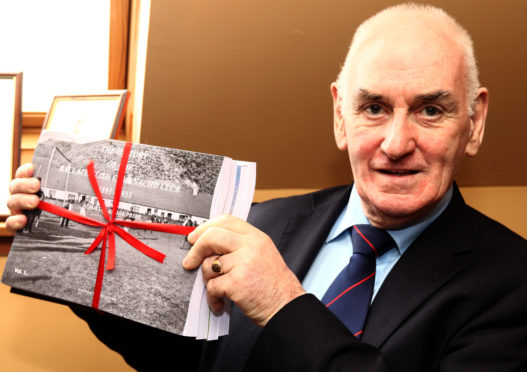It is such a story, it has taken 25 years to write it.
And now, the history of Ballachulish Shinty Club, spanning 125 years, has been documented in a new book.
Iain MacPhee, a former player and captain of the 1972 side, delved into the history of his beloved shinty club for the new book.
His publication, telling the story of Ballachulish Shinty Club from 1893 to the present day, is so large it has been split into four volumes.
Mr MacPhee said: “Ballachulish Shinty Club has been through a very mixed patch of late going through many highs and lows, going up the leagues and then back down and losing players to other teams.
“So really I wanted to do this to show these guys the history of their club because once they know how much history runs through their club, they would never think of leaving for another or packing up all together.”
The history spans back the full duration of the club’s existence, also noting particular periods where no shinty was played in the village due to conflicts and poignantly, the sacrifices Ballachulish came to face during wartime.
Mr MacPhee added: “Nine men from the village of Ballachulish were awarded military medals and commendation during the war and the club lost seven in total, which to me is an awful lot for a small village.”
Mr MacPhee has visited Edinburgh and Glasgow to unearth information from both the National Library and the Mitchell Library, alongside visiting the archive centres at Fort William and Inverness.
The historian, who now resides in Lochgilphead, began gathering pictures of former teams kitted out in the red and blue, but soon discovered match reports dating back to the club’s humble beginnings which he feels “really tell the story”.
Tales within tell of the Ballachulish side of 1899 who became the first side from Argyllshire to lift the Camanachd Cup, with their journey spanning the whole weekend, leaving on Friday by boat to Oban, before continuing by train to Glasgow, and then onwards to Perth.
Indeed the famed side was also praised by the local minister of Perth’s Episcopal Church for their humility in attending the Sunday morning service after becoming “world winning shinty heroes”, before heading for home on the Monday due to transportation logistics.
Shinty historian Hugh Dan MacLennan added: “There should be a copy of this in every shinty-playing community. It is a colossal work and the scope of it is just phenomenal and on a scale that has never been done like this before, not just for one club but for one area.
“Iain’s project has unearthed some fantastic new material and really he deserves a medal for this work at the very least.”
As well as displaying the importance of Ballachulish Shinty Club’s dominance in the game around the turn of the 20th century, the book also reveals the elusive record the club holds that has never been repeated.
In 1952, Ballachulish Shinty Club became the first side in history to hold both the MacTavish Cup and Celtic Society Cup in the same season.
The feat is all but impossible today as teams from the north compete in the MacTavish, with south sides battling it out for the Celtic Society. However, the impressive achievement was made possible by making clever use of the areas of North and South Ballachulish.
At the time, the Jubilee Park side would navigate across the straights of Loch Leven to North Ballachulish in order to meet the entry requirements of the MacTavish Cup competition. Matches were required to take place at the venue or away from home, and not the side’s home park in the village, so as to comply with the rules of the competition.
Nowadays, Ballachulish Shinty Club competes in just the Celtic Society Cup as they are registered as a south of Scotland shinty team.
